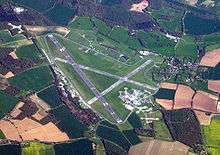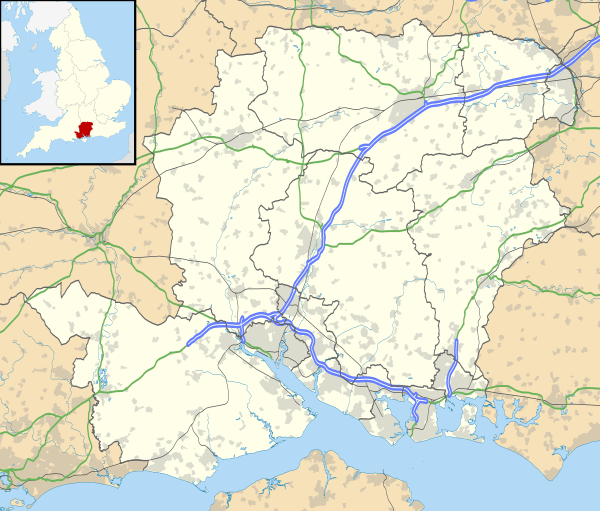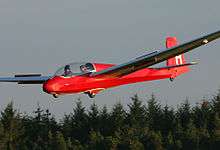Lasham Airfield
Lasham Airfield (ICAO: EGHL) is an aerodrome located 3.6 miles (5.8 km) north-west of Alton in Hampshire, England, in the village of Lasham.
Lasham Airfield | |||||||||||
|---|---|---|---|---|---|---|---|---|---|---|---|
 | |||||||||||
| Summary | |||||||||||
| Airport type | Private | ||||||||||
| Owner | Lasham Gliding Society | ||||||||||
| Operator | Lasham Gliding Society | ||||||||||
| Serves | Lasham, Hampshire, England | ||||||||||
| Location | Alton | ||||||||||
| Elevation AMSL | 618 ft / 188 m | ||||||||||
| Coordinates | 51°11′14″N 001°02′01″W | ||||||||||
| Website | https://www.lashamgliding.com/ | ||||||||||
| Map | |||||||||||
 EGHL Location in Hampshire | |||||||||||
| Runways | |||||||||||
| |||||||||||
It was built in 1942 and was a RAF Station during the Second World War, many significant operations being flown from it. The RAF ceased operations at Lasham in 1948, but a military aircraft company, General Aircraft Ltd, continued to fly from the airfield. From 1951 the main activity at Lasham airfield became recreational gliding.
The airfield is now owned by the largest British gliding club, also one of the world's largest, Lasham Gliding Society (LGS). It is also the location for 2Excel Engineering Ltd., a company that maintains large jet aircraft.
Pilots of powered aircraft visiting the airfield require prior permission and a briefing on its hazards: in particular dense concentrations of thermalling gliders (up to 100 gliders can be in the vicinity at once), winch cables up to 3,000 ft (910 m) above the ground, and occasional movements of large jet airliners. Over-flying aircraft are requested to not fly below 3,618 ft (1,103 m) QNH. The airfield frequency is 131.03 MHz.
Military history
The airfield was constructed in 1942. Initial operations (from November that year) were by 38 Wing, Army Co-operation Command.
Maps of the area before and after the airfield was constructed are displayed in the main corridor of the clubhouse of Lasham Gliding Society on the North side of the airfield off Avenue Road. Also displayed are photographs and other details of aircraft and personnel of the squadrons that flew from Lasham and are listed below.
In mid-1943, the airfield was transferred to RAF Fighter Command. Squadrons equipped with Hawker Hurricanes, Hawker Typhoons and Spitfires operated from Lasham. Later in 1943, it became a base for the bombers of No. 2 Group RAF, part of the 2nd Tactical Air Force. The squadrons of 2 Group used the de Havilland Mosquito and North American B-25 Mitchell.
Squadrons based at Lasham during the war
(apart from one- or two-night stays)
- No. 107 Squadron RAF Mosquito VI, arrived 1 Feb 1944; departed 23 Oct 1944
- No. 181 Squadron RAF Typhoon IB, arrived 5 Apr 1943; departed 6 Jun 1943
- No. 182 Squadron RAF Typhoon IB, arrived 3 May 1943; departed 2 Jun 1943
- No. 183 Squadron RAF Typhoon IB, arrived 3 May 1943; departed 30 May 1943
- No. 305 (Polish) Squadron Mitchell II and Mosquito VI, arrived 18 Nov 1943, departed 30 Oct 1944
- No. 320 (Netherlands) Squadron RAF Mitchell II, arrived 30 Aug 1943; departed 18 Feb 1944
- No. 412 Squadron RCAF, Spitfire VB, arrived 7 Mar 1943; departed 8 Apr 1943
- No. 602 (City of Glasgow) Squadron Auxiliary Air Force Spitfire VB, arrived 14 Apr 1943; departed 29 Apr 1943
- No. 613 (City of Manchester) Squadron AAF, Mosquito FB.VI, arrived 12 Oct 1943; departed 30 Oct 1944
A notable operation was by 613 Squadron. On 14 April 1944, at the request of resistance workers, six Mosquitos led by Wing Commander Robert Bateson bombed the Central Records Registry of the Gestapo in the Hague from a height of 50 ft (15 m). The accuracy was such that the incriminating records were burnt. There was loss of life amongst the Dutch and German staff, but there were few civilian casualties in the nearby streets.
On the nights preceding and following D-Day, the Mosquitos of 305 and 613 squadrons carried out low level attacks on enemy supply lines and armoured positions in Normandy to assist the allied landing forces.
Post-war
The airfield ceased to be an operational Royal Air Force station in 1948, though General Aircraft Ltd continued testing military gliders there. On 14 September 2006, a memorial at the entrance was dedicated to those who served at Lasham between 1942 and 1948.
In 1952, future world champion Mike Hawthorn occasionally used its perimeter track to test his Cooper-Bristol Formula Two car, as did others.[1]
In the 1960s the Space Department of the Royal Aircraft Establishment with its HQ at Farnborough, sited a number of satellite tracking and receiving dish aerials on the south side of Lasham airfield, one enclosed in a large white dome. These have now been removed, as have most of the buildings dating from World War II.
Gliding
Early days
In 1950 the Army Gliding Club was re-established by Major Tony Deane-Drummond, then an instructor at the Royal Military Academy Sandhurst. It operated at Odiham Airfield but after two accidents, the Commandant of Sandhurst ordered it to suspend operations. In early 1951 he ordered Major Deane-Drummond to restart the club at Lasham. In the meantime, the Surrey Gliding Club and Imperial College Gliding Club were both seeking a new home, because Redhill Aerodrome had many other users. The Surrey club and Imperial College therefore moved to Lasham in August 1951. As well as Tony Deane-Drummond, other notable instructors at that time included Ann Welch, Lorne Welch and Philip Wills. All of them went on to become British champions. A war-surplus barrage balloon winch was used for launches. Types flown included Slingsby T.21B trainer, Grunau Baby, and various other pre-war German sailplanes.
Lasham Gliding Society
Lasham Gliding Society (LGS) was established in 1958 to unify operations of the gliding clubs that had been operating since 1951. It later signed a long lease on the airfield from the Ministry of Defence. The airfield's boundaries were reduced but it still occupies over 500 acres (200 ha).
232 gliders are based at Lasham which are used by 751 members, plus social members.[2] The airfield is in constant use throughout the year and regularly hosts national and regional gliding championships. Oerlinghausen Airfield claims to be the world's largest gliding club with "around 25,000" glider launches annually[3] whereas Lasham launched 25,750 gliders in the year to 31 October 2014.[4] There are approximately 59,000 aircraft movements (departures and landings) annually (compared with Southampton Airport's 43,350).
In 1999, Lasham Gliding Society completed the purchase from the Ministry of Defence of the freehold to the airfield, making the final payment in 2001. It now owns all of the land within the fenced and gated area as well as the fields that form the undershoot area at each end of the main runway.

LGS's 90+[2] instructors train new pilots at all stages from Ab initio through to competitive cross-country flying. The training fleet consists of the following types:
- ASK 13 (Five basic trainers)
- ASK 21 (Five glass fibre trainers/Aerobatic Trainer)
- Duo Discus (advanced trainer)
- Duo Discus XLT (advanced trainer with turbo)
- Discus (three single seaters)
- Grob G-102 (three single seaters)
- Scheibe SF-25 Falke motor glider
The club uses three Skylaunch winches, normally delivering launch heights of 1500 ft and over 2000 ft in strong winds. The Club also operates five tugs:
and can call on several privately owned tugs in busy periods.
There are 213[2] other gliders at the airfield operated by private owners and by affiliated gliding clubs: Imperial College Gliding Club, University of Surrey Gliding Club, Southampton University Gliding Club, The Crown Service Gliding Club and the IBM Gliding Club. Lasham Youth run a Saturday Evening gliding course during the summer months which is open to everyone, providing an environment where young members can fly with people of similar ages. The Gliding Heritage Centre has a separate hangar on the south side containing 26 historic gliders, many of which are in flying condition.[5]
Derek Piggott was Chief Flying Instructor at Lasham during much of the period from 1953 to 1989. Ann Welch, Nicholas Goodhart, Frank Irving and Peter Twiss were also members for many years.
2Excel Engineering
Companies based at the south-west of the airfield have used the main runway since 1954 to bring in large jet aircraft for overhauls. In 1954 Dan-Air established a subsidiary, Dan-Air Engineering, at Lasham Airfield to service its own fleet and aircraft belonging to other operators. From the 1960s to 1980s, Lasham hosted a number of unusual aircraft - notably one of only two surviving Avro Yorks (G-ANTK in Dan-Air colours) - and was the resting home of aircraft from around the world which came to be scrapped, including most of the old Comet 4 fleet. Dan-Air ceased trading in 1992, and after a period of operation by FLS Aerospace, the facility was let by the society to aircraft maintenance company ATC Lasham Ltd.
On 2 October 2015, the holding company of ATC Lasham went into administration and closed its Southend branch with immediate effect.[6] New owners of ATC Lasham Ltd, 2Excel Engineering Ltd, signed a new lease with the Society on 23 December 2015 and have continued to maintain large jet aircraft at Lasham.[7]
The airfield occasionally provides storage for redundant aircraft. In 2008 these included aircraft from XL Airways UK, Futura International Airways, Zoom Airlines.[8] Six bmibaby 737s arrived in 2012 when the airline closed. Several aircraft are parked at Lasham during the Covid-19 recession.
References
- 'Mick' Hawthorn Hits the Headlines - Doug Nye, Motorsport magazine, April 2012, Page 132
- Verified with LGS management accounts July 2013
- Oerlinghausen web site Accessed 12 Jan 2011
- LGS management accounts for year to 31 October 2010
- "Gliding Heritage Centre". Retrieved 3 February 2017.
- "ATC Lasham based at Southend Airport goes into administration". Echo (Essex). 2 October 2015.
- Letter to members from Chairman.
- "Pictured: The area where airlines send redundant passenger jets". Daily Mail. 7 November 2008. Retrieved 7 November 2008.
External links
- Lasham Gliding Society
- Airport information for EGHL at World Aero Data. Data current as of October 2006.Source: DAFIF.
- Airport information for EGHL / QLA at Great Circle Mapper. Source: DAFIF (effective October 2006).
- Accident history for QLA at Aviation Safety Network
- RAF Lasham airfield at controltowers.co.uk
| Wikimedia Commons has media related to Lasham Airfield. |